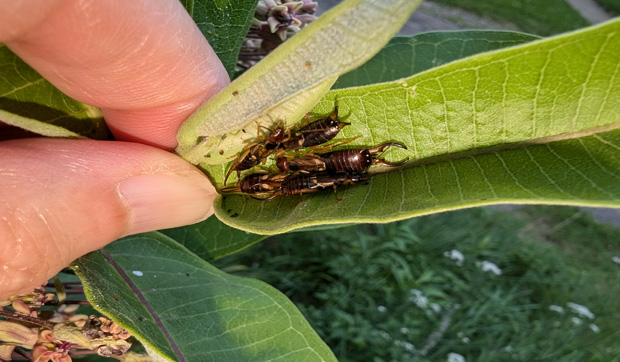Hello in there! Earwig droppings contain an aggregation pheromone that attracts both adults and nymphs, resulting in earwig clusters like this one inside some milkweed leaves. This plant was the only one among six milkweeds to host such a gathering.
July 19, 2024
The other day, just for kicks, I tossed out the word “earwig” to a group of nature-loving friends and asked them to share the first words that came to mind. Here’s a sampling of their responses:
Shiny. Creepy (from three different people). Icky (from two). Determined. Yucky. Pinchers. Somewhere between eww and wow. Destructive. Menacing. Dangerous. Star Trek. Extraterrestrial. Interesting. Insidious.
Oh, and one that came with an apology: Disgusting! Sorry, Pam!
I could go on, but I think you get the picture. In a day and age where it seems like everyone is divided on everything, there’s one cause that seems to have nearly 100% support: Eradicating Earwigs, Kablooey! Or EEK! for short.
I’ve lost track of the number of people who’ve commented on this year’s seeming explosion of these primitive little creatures. Folks are finding earwigs in their mailboxes, on their decks, patios and porches–and their deck, patio and porch furniture-as well as their basements and garages. Gardeners have plucked them from beneath plant saucers, untucked them from leaves and, in one case in Geneva, ended up composting 100 young zinnia plants that earwigs had munched to death.
So what’s up with that?
I wish I had a precise reason beyond, “Yup, it’s a big year for earwigs.” But while I can’t say for sure what’s driving these big numbers, I can think of a few factors that likely are playing a role.
For one, insect populations in general are prone to wide swings from year to year and include the occasional booms and busts. This year, from the looks of it, is a boom with a capital B.
For another, we had a mild winter. Earwigs mate in the fall, and females overwinter with their eggs underground. With really only one week of super-cold weather this past winter, I’m guessing a lot of earwig families made it through just fine.
Finally, we’ve had a lot of cloudy weather recently, and clouds actually make earwigs more active. Our recent rains, too, have helped by adding moisture to the dark areas where earwigs like to hang out.
Since they’re here to stay, at least for the foreseeable future, I thought it might be a good idea to share a few fun facts that, while not turning you into an earwig enthusiast, might just help you hate them a little less.
The most common species in our area is Forficula auricularia, the European earwig. Its scientific name is derived from the Latin words for little scissors-no doubt a reference to the cerci, or pincers, on the hind end-and “ear shaped,” which describes the outline of the hindwings, which are almost always kept tucked under the leathery forewings.
The common name is thought to come from the Old English earwicga which, if we break it down into its parts, means ear wiggly thing. The English word and its German counterpart, Ohrwig, both helped give rise to the mostly mistaken belief that earwigs will purposely seek shelter inside ears.
(I say mostly because the phenomenon of earwig-in-ear, while not common, isn’t totally fantastical. My friend Lorayne said it happened to her son. There’s also a YouTube video showing an earwig being extracted from the ear of a patient in South Korea. Most ears, however, have been marked safe from earwig intrusion.)
European earwigs were first noticed in 1907 in Seattle, likely having hitched a ride in plant material. The stealthy insect expanded its range quickly into Oregon and California. It was also spotted on the East Coast, in Rhode Island in 1911 and New York in 1912.
I couldn’t find a source for when European earwigs showed up in Illinois, but I do know that if anyone had asked me what words come to mind when I think of earwigs, I would have said, “Extra credit.” That’s because when I was a sophomore in high school, ca. 1970-something, and had to make an insect collection for biology class, I was more than a little envious that one kid-Tom Bergman-had found an earwig and received extra credit for what was at the time a rare bug.
Internet references say European earwigs showed up in Wisconsin in the 1980s and in Minnesota in the ’90s, so it could be Tom’s find was indicative of when they reached Illinois. Extra credit, indeed!
Regardless of when they arrived here, earwigs have been crawling around Earth for a very long time-somewhere in the range of 200 million years according to fossil records. Along the way they developed the endearing strategy of maternal care which means, yes, earwigs are good mommas. Females tend their eggs and defend them from intruders; they also feed their offspring throughout their first instar, or development stage.
Throughout their lives, earwigs are omnivores, feeding on everything from tender plants to dead ones, plus a host of creatures most folks consider pests: aphids, midges, psyllids a.k.a. plant lice, and scale insects. In turn they are preyed upon by wasps, spiders, and birds. Lots of birds! As a bonus, they’re an easy-to-capture (and free!) food for captive reptiles and amphibians, provided no pesticides have been used.
The next time you encounter an earwig, instead of going EEK!, you maybe–just maybe–could consider a hearty Yay! I’m Pleased as Punch for European Earwigs.
Pam Otto is the outreach ambassador for the St. Charles Park District. She can be reached at potto@stcparks.org.

